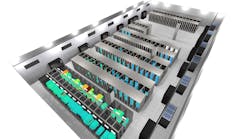Scaling Up Quickly? You Can’t Ignore These Five Factors
Holland Barry, Senior Vice President of on-demand services at Cyxtera Technologies, highlights five factors that can enable institutions scaling their IT departments and technology in an unprecedented time, amid the COVID-19 pandemic crisis.
Holland Barry, Senior Vice President of on-demand services, Cyxtera Technologies
In March, a mid-sized security and data management company based in Chicago was struggling to accommodate their new remote workforce as a result of the city’s shelter-at-home directive. They had a small footprint of Virtual Desktop Infrastructure (VDI) in a colocation facility, but it was insufficient to support the entire company’s workforce. They needed to quickly scale up their back-end server capacity. Waiting the typical eight to 10 weeks it usually takes to procure and install new infrastructure was simply not an option. Given the sensitive nature of their client base and the data they manage, utilizing public cloud was also not an option.
While many companies fall into the trap of the false dichotomy believing public cloud or on-prem are their only choices, there’s a third option that provided this company the secure, dedicated infrastructure it needed in a short timeframe. Bare metal platforms are ideally suited to today’s unprecedented demand for remote workforces, offering an on-demand, dedicated infrastructure at cloud speed.
Coloring Outside the Lines
Today, in an effort to keep organizations running, people are coloring outside of the security lines. They’re having to do unnatural things from home machines, laptops, and tablets until the proper infrastructure can be put in place, and employees can connect and use the internal infrastructure in a way that is secure and compliant.
When running quickly, it’s important to remember that not all bare metal platforms are created equal. Simply put, you don’t want to find yourself six months down the road regretting a decision made in haste.
Whether requirements call for specific network redundancy, or time and financial pressures require that you work with one of your existing carriers, you need carrier density options that offer significant agility and cost benefits. Bare metal lets you take advantage of the financial and operational flexibility of cloud with the control, performance, and security of enterprise-grade dedicated infrastructure.
Five Key Factors
Assuming you’ve decided to go the Enterprise Bare Metal route (good choice, I’ll add), what factors should you consider?
Security. A bare metal platform is only as good as its security. Speed won’t matter if your data is breached. When enterprises are under pressure to move quickly, as they are today, tradeoffs are made, usually in the security and compliance realm. Consider the fact that you have a new scope of infrastructure that might fall under the scope of your PCI audit. You’re utilizing an unfamiliar toolset, while simultaneously putting pressure on your team to learn a new product in order to get things up and running. All this scrambling can leave the door wide open for bad actors looking for ways to access the keys to the kingdom. Make sure your bare metal provider has thought about security at least as much (and hopefully much more!) than you have.
External Connectivity. When considering connectivity from outside the colocation center, you want a platform that allows for a choice of carriers. Most companies are not asking who your favorite network carrier is. Rather, they’re saying, “We’ve got this covered. You have access out to the Internet with our servers. Have fun.” The ability to bring your own carrier to the party is a tremendous advantage, as any IT professional knows. During times such as these, this becomes especially important when you consider that getting a circuit from a provider with whom you don’t have a legal contract can take months, and you have only days.
Looking beyond your immediate — and urgent — need, make sure that you also have access to very clean stitching to cloud on-ramps, connecting you to AWS, Azure and Google Cloud Platforms. While you may not need them today, it’s likely that other parts of your organization are considering their usage, and you want to make sure you’re ‘future-proofed’ and not caught flat-footed when the time comes.
Internal Connectivity. Internally, within the four walls of your data center, you want to ensure that you have the flexibility to define and customize your network topologies. Having full control over your VLANs to define how your infrastructure interacts lets you run your networks the same way you do today without the need to compromise your existing architecture. Again, few bare metal platform providers are offering this capability, but it’s one you should have.
Automation. Another factor to consider is automation. Does your provider allow you to reach your automation arms into their bare metal platform and provision network or internet connections? You want to find a provider that will let you steer the ship, with no interactions with an admin console.
Access. Check to see whether you have true access to infrastructure, and when I say that, I mean the ability to go into the BMC/BIOS and make system-level changes. Few providers allow this, despite its importance. You don’t want to find out the answer to this in the midst of a different crisis.
Capacity on Your Own Terms
Flexibility and control over connectivity, such as that offered by Cyxtera’s carrier-agnostic Enterprise Bare Metal Platform, are essential components of a successful Virtual Desktop Infrastructure (VDI) deployment. Whether requirements call for specific network redundancy, or time and financial pressures require that you work with one of your existing carriers, you need carrier density options that offer significant agility and cost benefits. Bare metal lets you take advantage of the financial and operational flexibility of cloud with the control, performance, and security of enterprise-grade dedicated infrastructure. What are you waiting for?
Holland Barry is the senior vice president of on-demand services at Cyxtera Technologies, where he oversees technology alliances for Cyxtera’s Enterprise Bare Metal Platform.





